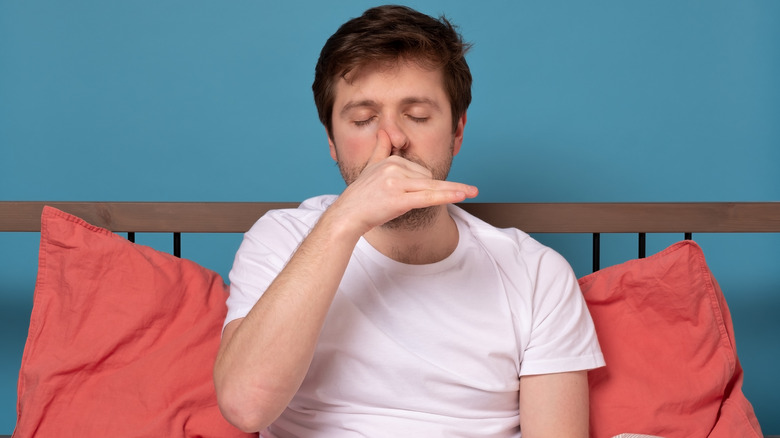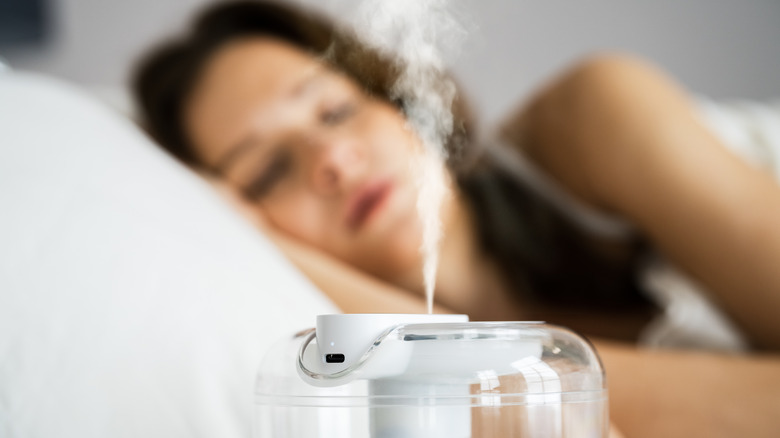There's A Reason One Of Your Nostrils Tends To Get More Clogged Than The Other When You're Sick
A clogged nostril can be quite the nuisance to say the least. What you may find surprising, however, is that restricted airflow is actually a natural part of what's known as the body's nasal cycle.
Although we may have two nostrils, our body intakes a greater amount of oxygen through only one nostril at a time (via Men's Health). How exactly does this work? In each nostril, you'll find a structure known as the inferior turbinate. Its function is to warm up the air we inhale, as well as increase its moisture levels, in order to reduce dryness as the air enters our lungs. However, to do so is no easy task. Therefore, the body targets one nostril at a time to make the most of its resources.
So where does congestion come into the picture? In order to warm and humidify this fresh air, greater blood flow is routed to one nostril over the other, which subsequently prompts swelling and narrowing of the airway. This switching of increased blood flow back and forth between nostrils occurs nearly every four to six hours, according to the Cleveland Clinic.
One nostril gets double the blood flow when we're sick
A single clogged nostril can also be the result of a deviated septum, chronic inflammation, nasal polyp obstruction, alcohol consumption, or even sleeping on one's side. "Side sleeping can definitely cause nasal congestion," Dr. Anthony Cornetta, board-certified otolaryngologist at NYU Langone, told PopSugar. "The side down to the pillow will get more stuffy due to gravity."
However, a one-sided clogged nose is usually at its worst when we're sick. Whether it's due to allergies or a cold virus, congestion can feel like it's at an all-time high when we're under the weather. Why is it that one of our nostrils always feels far more clogged than the other during these times? Essentially, all that back-and-forth blood flow between nostrils that's part of the everyday nasal cycle gets kicked up a notch when we're sick. With even more blood flow being sent to our nasal passages, we experience more swelling and mucus production than normal (per Men's Health). Usually, the congestion is more noticeable in the nostril that's already the focus of the nasal cycle at that moment. Once it switches, you'll likely feel more congestion in the opposite nostril.
How to ease the discomfort of a clogged nostril
Unfortunately, the nasal cycle will continue to do its thing whether we like it or not. However, what we can control are which treatment methods we use to help alleviate symptoms of a clogged nostril while we're ill.
When it comes to a stuffy nose, a nasal rinse can be our best friend. "Saline sprays are a great solution," Dr. Lakiea Wright, an allergist at Brigham and Women's Hospital, told Men's Health. "You're essentially helping your body wash out allergens or viruses." While neti pots are a popular choice, pharmacy squeeze-bottle kits are also an option. Additionally, boost your intake of hot liquids, as doing so may help your nose hairs expel mucus more quickly. Furthermore, along with keeping your internal system flushed with fluids, keep your external environment moist as well. Taking a steamy shower or using a humidifier may also help alleviate the discomfort of a clogged nostril.
Finally, rather than lying flat at night, try elevating your head with a couple extra pillows to help reduce nasal congestion as you sleep. Speak with your physician if nasal congestion lingers for more than ten days, in order to rule out any alternate potential causes.



